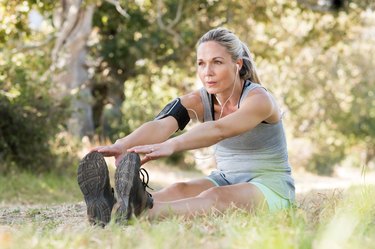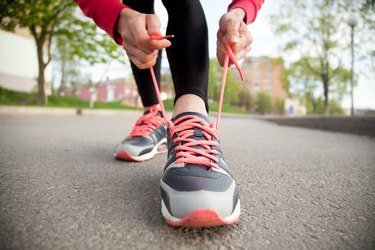
Your joints hold bursae, fluid-filled sacs that act as cushioning for the ligaments, muscles and tendons. If these become irritated, inflamed and swollen, you'll experience bursitis and the resulting tenderness and pain in the area.
Bursitis of the hip can make getting your regular cardio workouts done quite difficult. Most cardio involves movement of the hip joint, which only irritates the bursae further — impeding healing and aggravating pain.
Video of the Day
Video of the Day
Recovering from hip bursitis requires about six weeks of healing. During the most acute portion of this stage, you'll be looking to manage pain. Cardio should limit movement of the hips, so you might become really familiar with an arm ergometer.
Read more: Stretching Exercises for Hip Pain
Cycle Ergometer Workout
A cycle ergometer uses your upper body to rev your heart rate and challenge your cardiovascular system. You sit behind a set of bicycle cranks that you motor with your arms instead of your legs. This rests your hips, so you don't aggravate the bursitis but get the rush of a higher heart rate.
Because cranking uses different muscles and may seem awkward at first, you're best off approaching the machine as an interval workout.
Warm up with easy cranking for about 5 minutes, and then perform intervals of 20 to 40 seconds each. The intervals include an increase in intensity, which you achieve by either increasing how fast you turn the crank or by increasing the resistance. Between each high-intensity interval, turn the crank at an easy pace for about 1 minute.
If you're new to arm cranking, start with a workout lasting just about 15 minutes. Over time, as your arms and shoulders adapt, you can increase how long you spend doing intervals on the machine. As you become more able, feel free to make the intense intervals last longer — anywhere from 60 to 90 seconds.
Add in Walking
As healing progresses, your doctor should recommend the gradual restoration of your hips' range of motion, so you might add some walking to your routine. When you do, go for short periods of time that don't aggravate pain. Keep your pace slow and steady, eventually picking up to more of a power-walk intensity as you feel more able and don't experience increased pain. You may cover just a few blocks at first, and gradually add distance over the course of several days or even a few weeks.

Run and Walk Intervals
In the last two phases of healing, you'll look to regain full range of motion and prevent a recurrence of the condition. Gradually reintroduce more classic forms of cardio at this stage, including hiking, cycling and running. Of course, if you feel pain during these activities as your healing, consult with your physician.
A run-walk method is a cardio workout that helps reintroduce this motion back into your workouts. Only try this workout in the later phases of healing and once your doctor has said it's OK. Running when you have acute symptoms can set you back in terms of recovery.
Read more: Exercises to Avoid If You Have Hip Pain
Gradually warm up with a light walk for five to 10 minutes. Next, jog slowly for a minute and walk for 3 minutes. Gently means an easy pace — no sprinting. If the run was pain-free, repeat the sequence five to 10 times, depending on your stamina and pain level. If you feel pain, you're likely impeding healing and should return to a walk-only workout or continue to rest the lower body and perform cardio on the arm ergometer.
As time goes by and your healing progresses, you may be able to lengthen the run intervals and shrink the walk intervals. Most importantly, don't rush your way back to running, cycling or other cardio that involves the lower body. Bursitis is a signal from your joints that they need rest to heal.